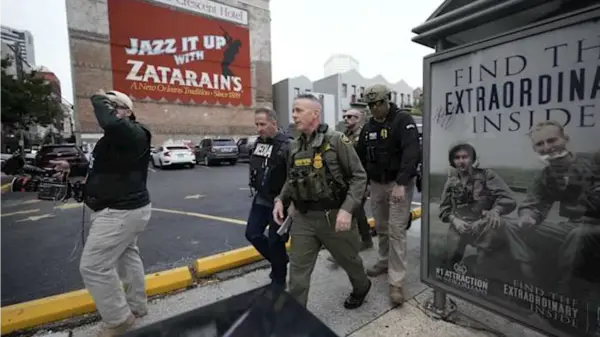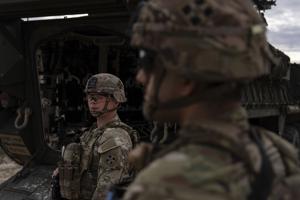UPDATE: The U.S. military has significantly expanded its presence at the Mexico-U.S. border, deploying 7,600 troops to deter illegal crossings. This urgent move, spearheaded by President Donald Trump, is unfolding in Nogales, Arizona, where military personnel are now integral to border enforcement operations.
This week, an Army scout in Nogales spotted a man attempting to cross the border wall. As alarms sounded and Border Patrol rushed to the scene, the individual retreated back into Mexico, highlighting the military’s role in heightened border security. With illegal crossings at a 60-year low, the presence of military forces aims to maintain this trend and bolster deterrence efforts.
U.S. troop deployments have tripled since earlier this year, indicating a shift from civilian law enforcement to a more militarized approach to border control. Alongside these troops, the Trump administration has pledged funding for an additional 3,000 Border Patrol agents, complete with $10,000 signing and retention bonuses to attract new recruits.
At the heart of this operation is a newly established command center near the Huachuca Mountains in southern Arizona. Here, battalion commanders oversee an extensive network of resources, including 117 armored Stryker vehicles and over 35 helicopters. This military buildup allows for rapid deployment to high-traffic areas, where illegal crossings have been previously observed.
“We can fly people into incredibly remote areas now that we see the cartels shifting course,” stated Army Maj. Gen. Scott Naumann, underscoring the military’s enhanced capabilities to respond to evolving border challenges. Troops are equipped with the authority to use deadly force if necessary, and standing military rules apply as they patrol in full battle gear.
While the rate of apprehensions has decreased, General Naumann warns against complacency, citing the potential for increased crossings as summer heat wanes. The focus remains on intercepting individuals who evade capture, especially in urban settings where time is critical.
“Deterrence is actually boring,” remarked Army Sgt. Ana Harker-Molina, reflecting the mixed feelings among soldiers about the sporadic nature of their duties. As an immigrant from Panama, Harker-Molina highlights the personal stakes involved, believing that the military’s presence alone is a powerful deterrent against illegal crossings.
Critics, including law professors and legal experts, express concerns over the implications of this militarization, as it may skirt around the Posse Comitatus Act, which restricts military involvement in civilian law enforcement. Joshua Kastenberg, a former Air Force judge, notes that this strategy operates in a “gray area” regarding legality but emphasizes the military’s longstanding authority on military bases.
The Trump administration’s military strategy extends beyond the border, involving protection of federal buildings and assistance to Immigration and Customs Enforcement in various states. This comprehensive approach signals a determined effort to showcase a strong stance on immigration enforcement.
As the situation develops, residents and officials alike are closely monitoring the impact of this military presence on local communities and the broader implications for immigration policy. The evolving dynamics at the border are poised to remain a focal point in national discussions, making this a critical moment in U.S. border security history.
Stay tuned for further updates as this story unfolds.





































































